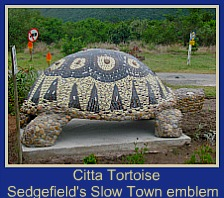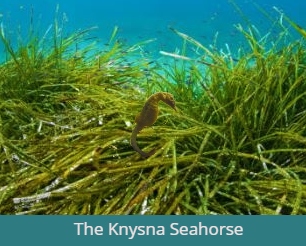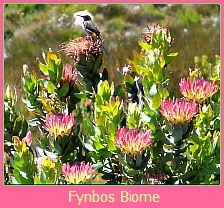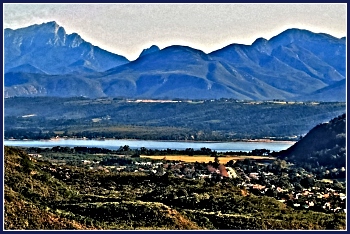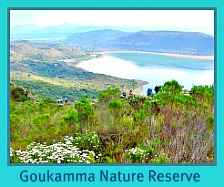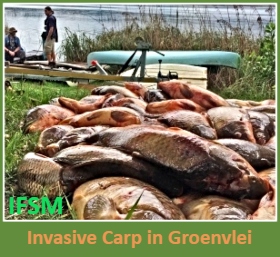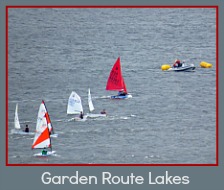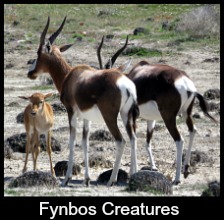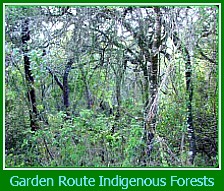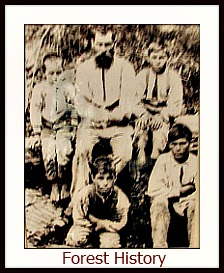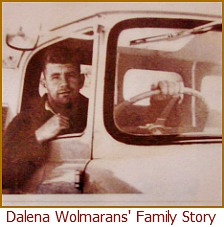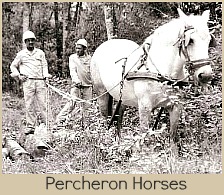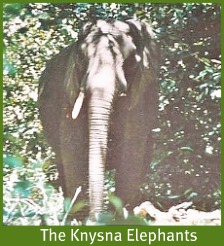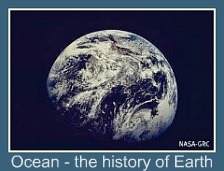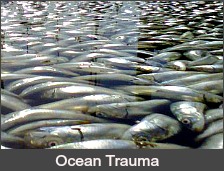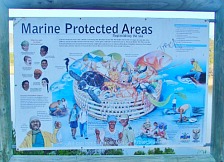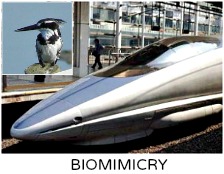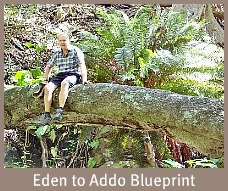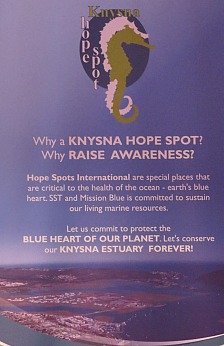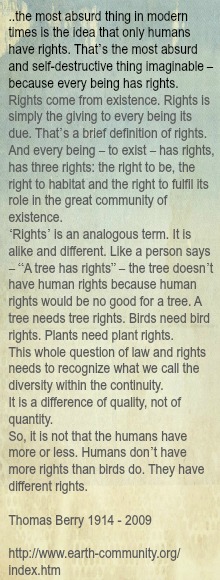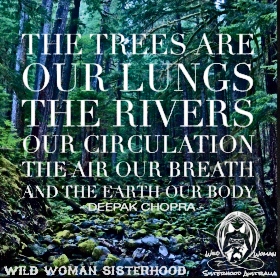Garden Route National Park
Sedge is now in the Park - the Garden Route National Park!
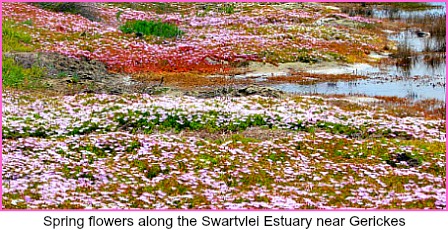
On 6 March 2009, the coastal region extending from
Wilderness in the south to Tsitsikamma in the north was declared the
Garden Route National Park by Minister of Environmental Affairs and
Tourism, Dr. Van Schalkwyk. It was launched at SANParks offices on
Thesen's jetty, Knysna. Described as “conservation without boundaries”,
this move will bring about the sharing of resources and management
experience for successful conservation practices.
It will facilitate important programs within the designated Garden Route National Park area like;
- fire management,
- alien species eradication,
- land consolidation,
- integrated land management
- improve the protection of important ecosystems
The Minister said "As administrative and ecological boundaries vary considerably, co-operative governance is essential."
The new Garden Route National Park will be approximately 121000 hectares of which 52500 hectares is newly proclaimed land.
- It will straddle the 2 provinces - the Eastern and Western Cape,
- 2 district municipalities - Eden and Cacadu
- 4 local municipalities -George, Knynsa, Bitou and Koukamma.
Diverse biomes include,
- the indigenous forests,
- the Knysna Estuary,
- Wilderness Lakes area,
- Marine Protected Areas,
- lowland fynbos
- the Cape Fold mountains and their catchment area.

Sedgefield and many other towns like it now have the distinctive honour to be assimilated into a conservation area, the all encompassing Garden Route National Park.
What a positive move for the environment! Hopefully it will make everyone more conscious of what conservation means and how they can do their part to implement it.
It is possible that those who are privileged to live in this piece of paradise can appreciate that at the end of the day our whole planet needs to be viewed as a conservation area. There is no Planet B!
This is all we have and the signs are now loudly proclaiming in 2018 that humans could be responsible for what distinguished scientist, Richard Leakey called "The Sixth Extinction" which was written way back in 1995.

Cooperative Governance of the
Garden Route National Park
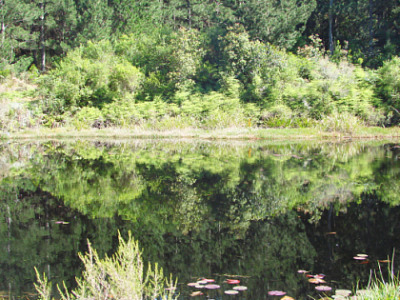 Reflections in the George Botanical Garden Ponds
Reflections in the George Botanical Garden PondsAuthorities have realised that diversely utilised areas adjacent to each other cannot be effectively controlled and managed as isolated pockets. Everyone has their own agendas and protects their interests, usually to the detriment of others and often simply because of lack of understanding of the issues. In every instance the most vulnerable participant, our environment, suffers most.
A cooperative governance and cohesive management plan involving all stakeholders within the Garden Route National Park is the only way to create win/win situations even if it makes the solutions more difficult to arrive at. They're unlikely to satisfy everyone but the hope is that short-sighted decisions can be avoided. When many disparate voices can express their opinions and negotiate in a transparent manner through a common forum then brainstorming could enable the best outcomes to be achieved. One hopes that altruism and generosity will win over greed and self-interest.
In Africa that can be a tall order, but we still have the opportunity to make the dream come true. A most important factor is having funds available to provide the meaningful monitoring and implementing of conservation practices when other concerns such as job creation, housing and attendant infrastructure are critical necessities and political levers for a great number of our population. These needn't be seen as opposing goals in our Garden Route National Park.
"The Earth is full of heaven and there are no unsacred places." Linda Truyers & John Nieslson
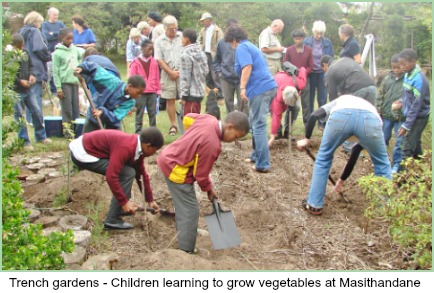
The very fact that this landmark Garden Route National Park has materialised shows that the “powers that be” recognise the need to protect this fragile and diverse environment. In a world of duelling dualities and competing interests, we are entitled to hope that all parties affected, from agriculture and forestry, to municipalities and tourism, will find the will and the way to work cooperatively with SANParks who are the custodians and second largest employer in the region.
If individuals within the system will rise above applying unsavory means to attain selfish ends and use head and heart to evolve workable successful outcomes what a meritorious achievement that will be! To conserve this unique combination of marine habitat, including beaches and coastal ecology, lakes, fynbos biome, indigenous forests and mountain water catchment areas is the ultimate prize now and for future generations.
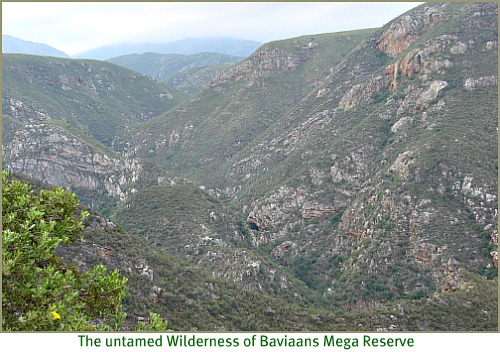
I believe that if genuine long term answers and appropriate conservation measures are sought, solutions will be found. The amazing and encouraging discovery of a small free ranging herd of elephants in the Knysna Forest should spur conservation bodies on to explore ingenious ways of allowing their co-existence with humans so that they remain the free and wild creatures they are meant to be.
Human nature is inherently geared to create solutions to challenges. Ground-breaking initiatives are paramount to ensuring not only humanity's survival but the survival of all other living things to revere the untouchable essence of things and fundamental qualities of existence that make life meaningful. These concepts experimented with in this new Garden Route National Park can become a blueprint for similar models elsewhere.
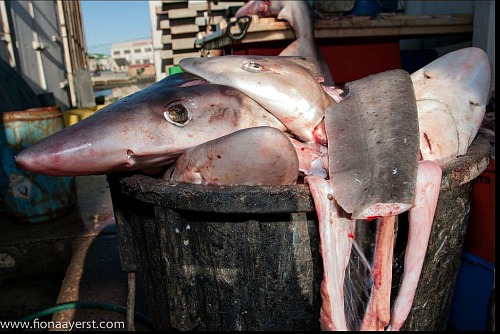
The Eden to Addo Initiative is one such visionary project. Born in 2006 from a seemingly impossible dream of a few private individuals, the formation of the Mega Garden Route National Park in 2009 and the subsequent creation of the Garden Route Initiative will assist in many ways this earlier exciting and landmark blueprint for the protection of this region’s biodiversity.
The window of opportunity must be seized while time still allows as the demand for land for human settlement is unceasing and a point will be reached when it could become impossible to achieve this scenario.
"Only after the last tree has been cut down
Only after the last river has been polluted
Only after the last fish has been caught
Only then will you find that money cannot be eaten"
Cree Indian prophecy
Abandoned dead sharks -100 million sharks are killed each year either intentionally or as by-catch by fisheries. This massive killing of apex predators is one of many factors seriously threatening the health of our oceans.
The Garden Route Biosphere Reserve
The "conservation without boundaries" concept had the potential to protect the whole Garden Route region from damaging exploitation by establishing innovative mechanisms allowing people with all their associated complex human activities to sustainably interact with this fragile and beautiful natural environment.
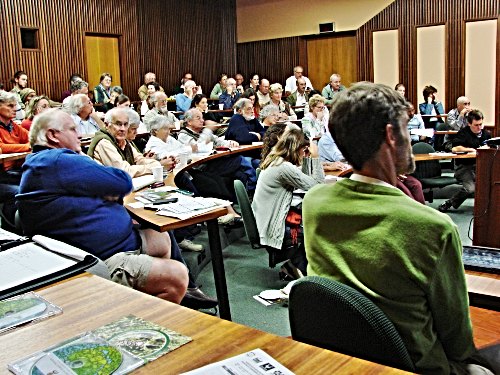 Attendees at the Garden Route Initiative meeting in George Municipality Auditorium.
Attendees at the Garden Route Initiative meeting in George Municipality Auditorium.To consolidate and sustain this effort, many people from all walks of life actively and deeply invested in materialising the next step, which was to apply to UNESCO (United Nations Educational, Scientific and Cultural Organisation) to gain recognition for this and an even larger adjacent area to be proclaimed a Biosphere Reserve. Called the GRI (Garden Route Initiative) it was engineered under the Cape Action Group for People and the Environment.
For over two years, data on the fauna, flora and geology found in this area was painstakingly gathered - enough to fill 16 lever arch files with over 8 000 pages of required documentation. As the brainchild of Eden District Municipality (Eden DM) Environmental Specialist Vernon Gibbs-Halls, and a consultant, Julie Carlisle, they were the driving force behind the compilation of the application.
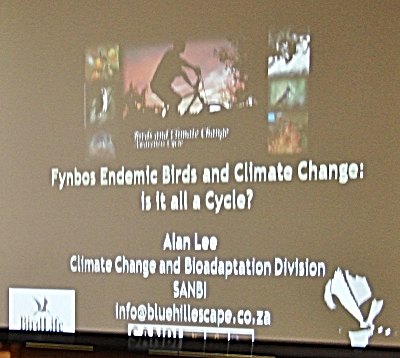 One of the monthly GRI presentations at the George Municipality Auditorium
One of the monthly GRI presentations at the George Municipality AuditoriumIt required buy-in from government departments, municipalities, businesses, farms, specialised groups and private individuals. Vernon Gibbs-Halls had to oversee and co-ordinate the mountain of information to be submitted from all the parties involved. Monthly meetings took place in the George Auditorium where specialists in their area of expertise made presentations on a wide range of subjects and these became the bedrock on which the application to UNESCO was based.
Vernon Gibbs-Halls managed to acquire funding from the Table Mountain Fund (TMF), in order to launch the application process. Additional funding was raised by the Bitou Valley Foundation, for the following:
- Garden Route Socio-economic study
- Climate Change Adaptation Plan
- Alien Invasive Eradication Plan
- Fundraising Strategy Responsible Tourism Strategy
- Educational and Marketing Strategy.
The efforts by Mr Errol Finkelstein, a Chartered Accountant from Plettenberg Bay, paved the way for the GRB to be registered as a Non-Profit Organisation (NPO).
It took 8 years from the time the Garden Route was proclaimed a National Park to 2018 for the GRI to compile and complete and then submit this onerous project. It was all worthwhile when in 2018 the larger demarcated area achieved the coveted Biosphere status.
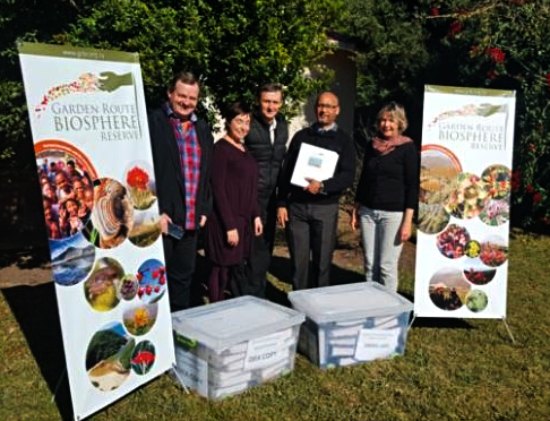 Mr Vernon Gibbs-Halls (Eden DM Environmental Specialist: Biodiversity and Coastal Management), Ms Mary Jane Waite, Mr Johan Compion (Eden DM Manager: Environmental Services), Mr Godfrey Louw (Eden DM Municipal Manager) and Ms Julie Carlisle (Bitou ValleyFoundation)
Mr Vernon Gibbs-Halls (Eden DM Environmental Specialist: Biodiversity and Coastal Management), Ms Mary Jane Waite, Mr Johan Compion (Eden DM Manager: Environmental Services), Mr Godfrey Louw (Eden DM Municipal Manager) and Ms Julie Carlisle (Bitou ValleyFoundation)Mr Gibbs-Halls ellaborated that: “Biosphere reserves are areas comprising terrestrial, marine and coastal eco-systems. Each reserve promotes solutions reconciling the conservation of biodiversity with its sustainable use. Biosphere reserves are ‘Science for Sustainability support sites’ – special places for testing interdisciplinary approaches to understanding, managing changes and interactions, between social and ecological systems. It includes conflict prevention and management of biodiversity.
UNESCO’s Man and the Biosphere Programme (MAB) was launched in 1971 and is known as an Intergovernmental Scientific Programme that aims to establish a scientific basis for the improvement of relationships between people and the environment.
MAB combines the natural and social sciences, economics and education, to improve human livelihoods and the equitable sharing of benefits. It aims to safeguard natural and managed ecosystems, thus promoting innovative approaches to promote culturally appropriate, economic development and environmental
sustainability.
Biosphere reserves are nominated by national governments and remain under the
sovereign jurisdiction of the states where they are located, but remain internationally recognised.
There are three zones in a biosphere reserve.
1. The core area(s) comprises a strictly protected ecosystem that contributes to the conservation of landscapes, ecosystems, species and genetic variation.
2. A buffer zone surrounds or adjoins the core areas, and is used for activities compatible with sound ecological practices that can reinforce scientific research, monitoring, training and education.
3. A transition area is the part of the reserve where the greatest activity is allowed, fostering economic and human development, that is socio-culturally and ecologically sustainable.”
In conclusion, Mr Gibbs-Halls said: “I would like to take this opportunity to thank everyone for their valuable input and hours of work that contributed to this application. A special word of thanks and acknowledgement to Ms Julie Carlisle, Ms Mary Jane Waite, Ms Gwenith Penry, Mr Hennie Swanevelder, Mr Errol Finkelstein (Chair), Mr Willem Smith, Mr Albert Ackhurst, Mr Bevin Arendse, Ms Anne Lise Schutte-Vlok, Ms Ruida Stanvliet, Mr Stephen Holness, Ms Maretha Alant, Ms Londeka Phetha and all my colleagues at Eden DM, Provincial Government and National Government. Finally, a heartfelt thank you to the TMF and all the people of the Garden Route.” From an article in South Capenet Times - The Gremlin 10-07-2016
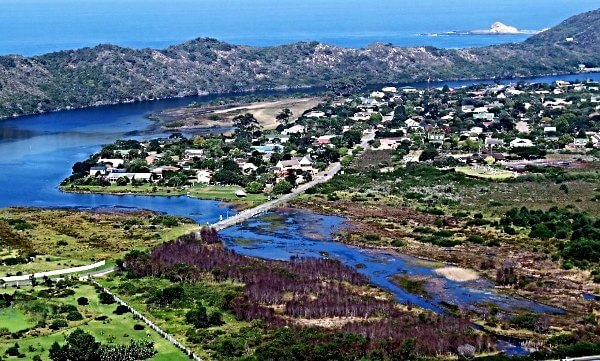 Beautiful Sedgefield, a place worthy of conservation.
Beautiful Sedgefield, a place worthy of conservation.With the recognition of the Biosphere in place, Government representatives, parastatal bodies, NGOs, ratepayer organisations, research, institutions and the general public will be given the opportunity of being nominated as members of the management committee.
The municipalities included in the Biosphere are George, Knysna, Bitou, Kouga, Goukamma, Eden District and Sarah Baartman District.
The Current State of the Biosphere Reserve
It was a big win for the environment at the time and it has put the brakes on environmental destruction in some respects because so many people are now more environmentally conscious. Unfortunately politically motivated municipalities are revealing they do not have the required expertise to fulfil the tasks of maintenance or foresight to implement the necessary infrastructure to support a constantly growing and expanding population. A 5 year tenure in a hierarchical position is not enough time for individuals to get a grasp of the essentials required to manage a town and to plan for future needs, never mind care about any of the ecological issues of unsustainability.
In the face of these increasing failings, ordinary citizens are taking matters into their own hands and assisting in ways they can have some mitigating effect on poor service delivery, lack of maintenance and downright neglect. Examples of community involvement in Sedgefield are the NGOs such as Masithandane with a comprehensive range of projects involving people from the cradle to the grave, Revive Sedgefield are a group smartening up our town's appearances aesthetically and practically, SAM (Sedge Animal Matters) takes care of lost and abandoned animals, and Sedgefield Ratepayers is our watch dog determined to call our Municipality to account on its budget spend and lack of service delivery. We also have 2 conservancies, the Island and Cola Beach. Not to be forgotten are our three phenomenal outdoor Saturday markets enabling us to buy local and support locals.
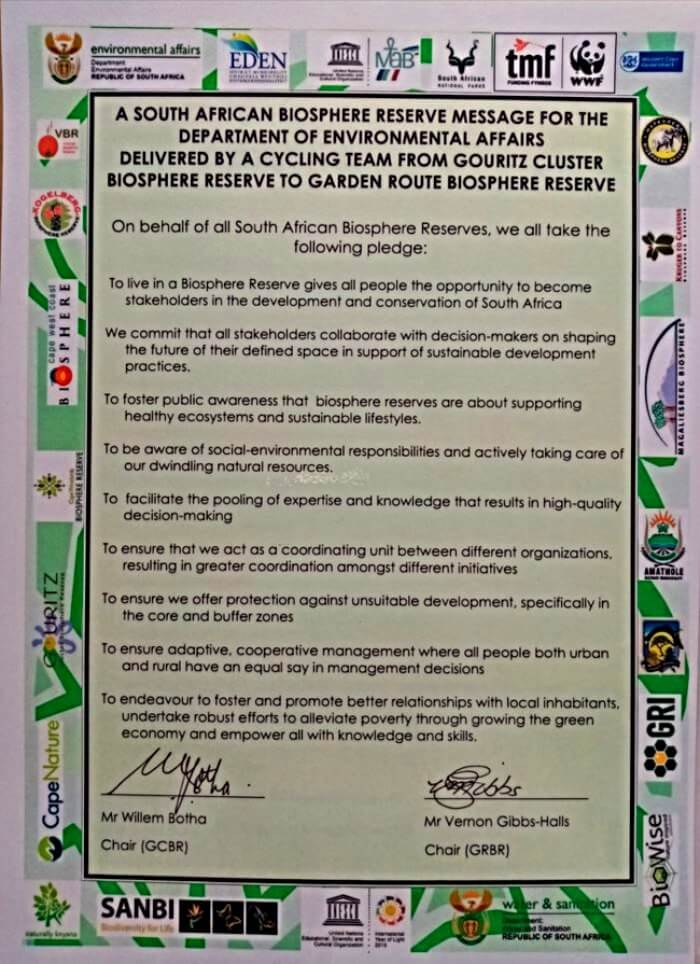
How to do your bit for Conservation
The best way for individuals to get involved is on a personal and local level, in manageable bites. I always think that if we each do whatever we can, all the little bits add up in the end to a huge pile of difference. Once you start, new ideas present themselves and the whole project gathers momentum! Whether its
- installing rain water tanks
- showering instead of bathing
- only using your washing machine when you have a full load
- only using a tumble-dryer when you HAVE to
- switching lights off when you leave a room
- making sure you have no pipe leaks or dripping taps
- installing solar heating
- reducing landfill by recycling plastic and paper
- reducing landfill by composting your organic waste
- using chemical free home cleaners
- using energy saving light bulbs
- insulating your geyser
- growing your own vegetables without fertilizers or pesticides
- taking a bag to pick up trash whilst walking
- walking/cycling around the village instead of using a gas guzzling SUV
- having a lift club to taxi children to school
- buying local
– there’s numerous ways that we can lessen our human impact
on the environment which in this case is our very own Garden Route Biosphere Reserve!
It is an honour and a responsibility to justify the accreditation and should not be taken lightly. We owe it to our planet and to the future of the human race.
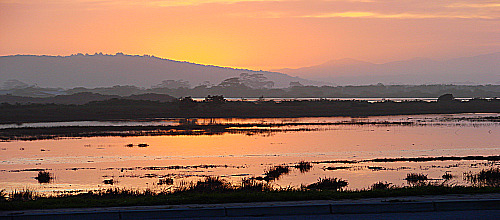

Links to Related Sites


The Garden Route Biosphere Reserve has a multi-disciplinary team of qualified professionals and volunteers that ensure that efforts to conserve the environment are sustainable and effective. The challenges to meet the needs of a growing population are huge.
Work undertaken in this partnership through the C.A.P.E. programme includes systematic fine scale biodiversity planning, consolidating protected areas in the critical lowlands and marine areas, promoting conservation stewardship among private landowners, and working towards promoting growth in the number of jobs, training and entrepreneurial opportunities through biodiversity management, sustainable natural resource use and responsible tourism.

The Green Times is SA's bi-weekly green newspaper! If you are concerned and excited about the greening of our society, then this is your news portal. Use our green calendar to know what's happening - attend, be informed and spread this crucial education wherever you go. Subscribe and consistently learn how to green up all aspects of your life and work, so you can help lead our society transitioning towards a sustainable future.

Proclaimed as "A World in one country" a holiday to South Africa is exactly that! No other holiday destination that Safari365 specialises in offers the variety of attractions and experiences, infrastructure and value that can be found in South Africa.

